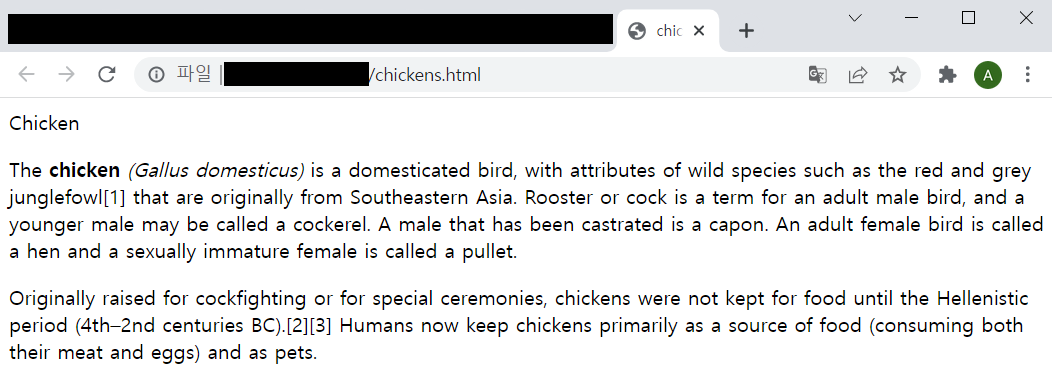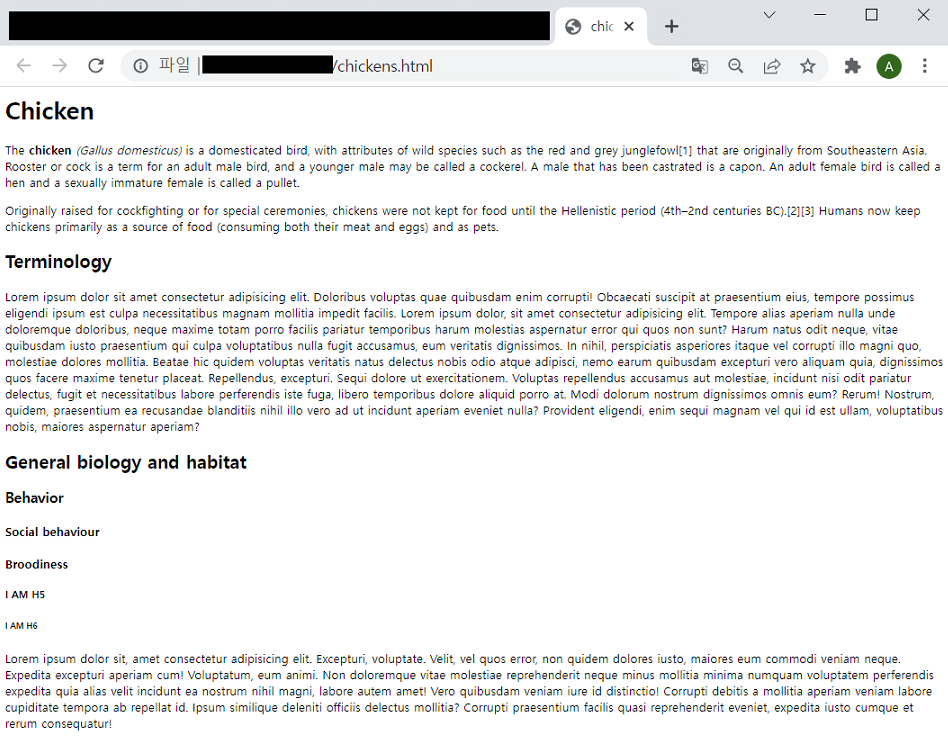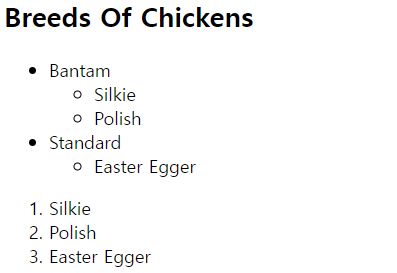
Udemy Web Developer Bootcamp Section 3
HTML
HTML is an example of something called a markup language. It stands for hypertext markup language.
HTML is not a full blown programming language or what most people would consider a programming language where we implement complex logic and we don't have anything like that with HTML. It's just about marking up a document.
HTML is a language or a syntax that we use to mark up documents, web pages.
To write HTML, we use what are called HTML elements. There are quite a few of them, things like image elements or form elements or link elements or heading elements, bold things, italicize. But we define them using the syntax, this general pattern where we wrap a tag in opening tag <p> and a closing tag </p> around some content.
Chicken Page.HTML
Chicken
The <b>chicken</b> <i>(Gallus domesticus)</i> is a domesticated bird, with attributes of wild species such as the red and grey junglefowl[1] that are originally from Southeastern Asia. Rooster or cock is a term for an adult male bird, and a younger male may be called a cockerel. A male that has been castrated is a capon. An adult female bird is called a hen and a sexually immature female is called a pullet.
MDN (Mozilla Developer Network)
MDN is a resource that covers the basics and more, not just the basics of Web technologies. So resources for developers written by developers think of it as Wikipedia for HTML, CSS, JavaScript and browsers and a whole bunch of other stuff that explains the rules of HTML.
https://developer.mozilla.org/en-US/docs/Web/HTML
Paragraph Elements
The <p> HTML element represents a paragraph. Paragraphs are usually represented in visual media as blocks of text separated from adjacent blocks by blank lines and/or first-line indentation, but HTML paragraphs can be any structural grouping of related content, such as images or form fields.
Chicken
<p>The <b>chicken</b> <i>(Gallus domesticus)</i> is a domesticated bird, with attributes of wild species such as the red and grey junglefowl[1] that are originally from Southeastern Asia. Rooster or cock is a term for an adult male bird, and a younger male may be called a cockerel. A male that has been castrated is a capon. An adult female bird is called a hen and a sexually immature female is called a pullet.</p>
<p>
Originally raised for cockfighting or for special ceremonies, chickens were not kept for food until the Hellenistic period (4th–2nd centuries BC).[2][3]
Humans now keep chickens primarily as a source of food (consuming both their meat and eggs) and as pets.
</p>
Heading Elements
The <h1> to <h6> HTML elements represent six levels of section headings. <h1> is the highest section level and <h6> is the lowest.
<h1>Chicken</h1>
<p>The <b>chicken</b> <i>(Gallus domesticus)</i> is a domesticated bird, with attributes of wild species such as the red and grey junglefowl[1] that are originally from Southeastern Asia. Rooster or cock is a term for an adult male bird, and a younger male may be called a cockerel. A male that has been castrated is a capon. An adult female bird is called a hen and a sexually immature female is called a pullet.</p>
<p>
Originally raised for cockfighting or for special ceremonies, chickens were not kept for food until the Hellenistic period (4th–2nd centuries BC).[2][3]
Humans now keep chickens primarily as a source of food (consuming both their meat and eggs) and as pets.
</p>
<h2>Terminology</h2>
<p>Lorem ipsum dolor sit amet consectetur adipisicing elit. Doloribus voluptas quae quibusdam enim corrupti! Obcaecati suscipit at praesentium eius, tempore possimus eligendi ipsum est culpa necessitatibus magnam mollitia impedit facilis. Lorem ipsum dolor, sit amet consectetur adipisicing elit. Tempore alias aperiam nulla unde doloremque doloribus, neque maxime totam porro facilis pariatur temporibus harum molestias aspernatur error qui quos non sunt?
Harum natus odit neque, vitae quibusdam iusto praesentium qui culpa voluptatibus nulla fugit accusamus, eum veritatis dignissimos. In nihil, perspiciatis asperiores itaque vel corrupti illo magni quo, molestiae dolores mollitia.
Beatae hic quidem voluptas veritatis natus delectus nobis odio atque adipisci, nemo earum quibusdam excepturi vero aliquam quia, dignissimos quos facere maxime tenetur placeat. Repellendus, excepturi. Sequi dolore ut exercitationem.
Voluptas repellendus accusamus aut molestiae, incidunt nisi odit pariatur delectus, fugit et necessitatibus labore perferendis iste fuga, libero temporibus dolore aliquid porro at. Modi dolorum nostrum dignissimos omnis eum? Rerum!
Nostrum, quidem, praesentium ea recusandae blanditiis nihil illo vero ad ut incidunt aperiam eveniet nulla? Provident eligendi, enim sequi magnam vel qui id est ullam, voluptatibus nobis, maiores aspernatur aperiam?</p>
<h2>General biology and habitat</h2>
<h3>Behavior</h3>
<h4>Social behaviour</h4>
<h4>Broodiness</h4>
<h5>I AM H5</h5>
<h6>I AM H6</h6>
<p>Lorem ipsum dolor sit, amet consectetur adipisicing elit. Excepturi, voluptate. Velit, vel quos error, non quidem dolores iusto, maiores eum commodi veniam neque. Expedita excepturi aperiam cum! Voluptatum, eum animi.
Non doloremque vitae molestiae reprehenderit neque minus mollitia minima numquam voluptatem perferendis expedita quia alias velit incidunt ea nostrum nihil magni, labore autem amet! Vero quibusdam veniam iure id distinctio!
Corrupti debitis a mollitia aperiam veniam labore cupiditate tempora ab repellat id. Ipsum similique deleniti officiis delectus mollitia? Corrupti praesentium facilis quasi reprehenderit eveniet, expedita iusto cumque et rerum consequatur!</p>
HTML Boilerplate
HTML SKELETON(Boilerplate) is standardised markup that needs to go in every document you create, every single HTML page. So even though our browser is letting us slide without it, we need to have it.
<!DOCTYPE html>
<html>
<head>
<title>Chicken - Yekipedia</title>
</head>
<body>
<h1>Chicken</h1>
<p>The <b>chicken</b> <i>(Gallus domesticus)</i> is a domesticated bird, with attributes of wild species such as the
red and grey junglefowl[1] that are originally from Southeastern Asia. Rooster or cock is a term for an adult
male bird, and a younger male may be called a cockerel. A male that has been castrated is a capon. An adult
female bird is called a hen and a sexually immature female is called a pullet.</p>
<p>
Originally raised for cockfighting or for special ceremonies, chickens were not kept for food until the
Hellenistic period (4th–2nd centuries BC).[2][3]
Humans now keep chickens primarily as a source of food (consuming both their meat and eggs) and as pets.
</p>
<h2>Terminology</h2>
<p>Lorem ipsum dolor sit amet consectetur adipisicing elit. Doloribus voluptas quae quibusdam enim corrupti!
Obcaecati suscipit at praesentium eius, tempore possimus eligendi ipsum est culpa necessitatibus magnam mollitia
impedit facilis. Lorem ipsum dolor, sit amet consectetur adipisicing elit. Tempore alias aperiam nulla unde
doloremque doloribus, neque maxime totam porro facilis pariatur temporibus harum molestias aspernatur error qui
quos non sunt?
Harum natus odit neque, vitae quibusdam iusto praesentium qui culpa voluptatibus nulla fugit accusamus, eum
veritatis dignissimos. In nihil, perspiciatis asperiores itaque vel corrupti illo magni quo, molestiae dolores
mollitia.
Beatae hic quidem voluptas veritatis natus delectus nobis odio atque adipisci, nemo earum quibusdam excepturi
vero aliquam quia, dignissimos quos facere maxime tenetur placeat. Repellendus, excepturi. Sequi dolore ut
exercitationem.
Voluptas repellendus accusamus aut molestiae, incidunt nisi odit pariatur delectus, fugit et necessitatibus
labore perferendis iste fuga, libero temporibus dolore aliquid porro at. Modi dolorum nostrum dignissimos omnis
eum? Rerum!
Nostrum, quidem, praesentium ea recusandae blanditiis nihil illo vero ad ut incidunt aperiam eveniet nulla?
Provident eligendi, enim sequi magnam vel qui id est ullam, voluptatibus nobis, maiores aspernatur aperiam?</p>
<h2>General biology and habitat</h2>
<h3>Behavior</h3>
<h4>Social behaviour</h4>
<h4>Broodiness</h4>
<h5>I AM H5</h5>
<h6>I AM H6</h6>
<p>Lorem ipsum dolor sit, amet consectetur adipisicing elit. Excepturi, voluptate. Velit, vel quos error, non quidem
dolores iusto, maiores eum commodi veniam neque. Expedita excepturi aperiam cum! Voluptatum, eum animi.
Non doloremque vitae molestiae reprehenderit neque minus mollitia minima numquam voluptatem perferendis expedita
quia alias velit incidunt ea nostrum nihil magni, labore autem amet! Vero quibusdam veniam iure id distinctio!
Corrupti debitis a mollitia aperiam veniam labore cupiditate tempora ab repellat id. Ipsum similique deleniti
officiis delectus mollitia? Corrupti praesentium facilis quasi reprehenderit eveniet, expedita iusto cumque et
rerum consequatur!</p>
</body>
</html>
List Elements
<ul>
<li>Bantam
<ol>
<li>Silkie</li>
<li>Polish</li>
</ol>
</li>
<li>Standard
<ul>
<li>Easter Egger</li>
</ul>
</li>
</ul>
Anchor Tags
The <a> HTML element (or anchor element), with its href attribute, creates a hyperlink to web pages, files, email addresses, locations in the same page, or anything else a URL can address.
<a href="http://www.google.com">I AM LINK!!</a>
<a href="about.html">ABOUT PAGE</a>
Image
<img src=“(address of a image)” alt=“this is a image.”>Comments
<!— this is a comments —>